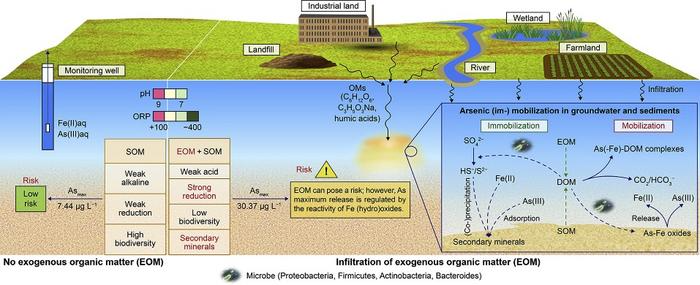A study was conducted by investigators from the Chinese Research Academy of Environmental Sciences to evaluate the effects of environmental factors and microbial communities on arsenic (As) mobilization. The observations shed light on the biogeochemical processes that contribute to As release.
 Graphical abstract. Image Credit: Environmental Science and Ecotechnology
Graphical abstract. Image Credit: Environmental Science and Ecotechnology
The study, published in the journal Environmental Science and Ecotechnology, concentrated on processes that influence As behavior in the environment, like desorption, reduction, complexation, and co-precipitation. A critical control mechanism was recognized as the interaction between Fe (hydro) oxides and organic matter (OMs), especially dissolved organic matter (DOM).
The OMs were identified using fluorescence indices, which indicated continuous biological activity throughout the experiment.
When the microbial community was analyzed, it was discovered that there were bacteria present that could reduce Fe, Mn, and As in addition to bacteria involved in EOM-based metabolic transformations. When bio-reactive and chemically reactive OMs were added, they facilitated the release of As, Fe, and Mn by creating a reduction environment, especially at high OM concentrations.
Glucose and sodium lactate, which are easily metabolized by microbes, resulted in higher releases than the OM-free control group. Humic acid (HA), a chemically reactive OM, had a major impact on the release of Fe and Mn but had a lesser impact on As.
The research also discovered secondary Fe minerals, like siderite and mackinawite, which incorporated As and made a significant contribution to the decrease in As, Fe, and Mn concentrations in the aqueous phase. As indicated by specific functional groups, microbial decomposition altered the properties of DOM, resulting in the production of amino acids and the presence of polysaccharides.
Moreover, canonical correspondence analysis (CCA) and redundancy analysis (RDA) were used in the study to investigate the relationship between environmental factors, the microbial community, and As mobilization. Positive correlations were found between As(III), Fe, and Mn, while a negative correlation was noticed with oxidation–reduction potential (ORP).
Numerous bacterial genera linked to As metabolism were discovered, highlighting their importance in the release process.
This research enhances the knowledge of the complex factors affecting the release of arsenic (As) and also sheds light on the microbial processes responsible for As mobilization in aquatic environments.
The observations have significant management and mitigation ramifications for groundwater pollution brought on by EOM infiltration. It is determined that certain locations, including landfills, petrochemical sites, and managed aquifer recharge projects, are particularly susceptible to contamination. Exploring the impacts of hydrodynamic and hydrogeochemical environments in real-world applications will require more research.
These results highlight the need for comprehensive approaches to successfully manage and minimize the environmental risks connected to EOM infiltration, with the goal of preserving groundwater quality.
Journal Reference:
Feng, F., et al. (2023). Exogenous-organic-matter-driven mobilization of groundwater arsenic. Environmental Science and Ecotechnology. doi.org/10.1016/j.ese.2023.100243.